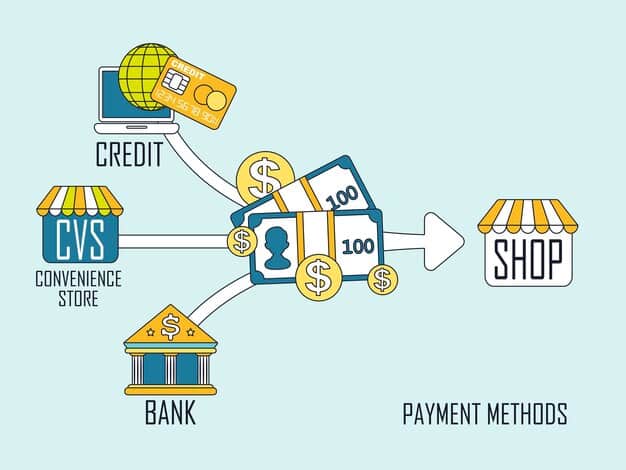Real-Time Payments (RTP) in the US: A Business Guide for the Next 6 Months

Real-Time Payments (RTP) are revolutionizing financial transactions in the US, offering businesses immediate payment processing, enhanced cash flow management, and improved operational efficiency, making it crucial for them to understand and implement RTP solutions within the next six months to stay competitive.
Are you ready to transform your business’s payment processes? Real-Time Payments (RTP) in the US: What Businesses Need to Know to Implement Them in the Next 6 Months presents a significant opportunity for companies to enhance efficiency, improve cash flow, and offer a better customer experience. Let’s explore how you can leverage RTP to stay ahead in today’s fast-paced market.
Understanding Real-Time Payments (RTP) in the US
Real-Time Payments (RTP) are a modern method of electronic funds transfer that enables payments to be initiated and settled almost instantaneously, 24/7, 365 days a year. Unlike traditional payment systems that may take hours or even days to process transactions, RTP offers immediate availability of funds, providing numerous benefits for businesses and consumers alike.
Key Features of RTP
RTP systems have several defining features that differentiate them from other payment methods. Understanding these features is crucial for businesses considering adopting RTP.
- Immediate Settlement: Transactions are settled in real-time, providing immediate access to funds.
- 24/7 Availability: RTP systems operate around the clock, enabling payments at any time, including weekends and holidays.
- Enhanced Security: RTP networks often incorporate advanced security measures, such as tokenization and encryption, to protect against fraud.
- Data-Rich Transactions: RTP allows for the inclusion of detailed remittance information, facilitating reconciliation and improving transparency.
The benefits of these features are numerous. Businesses can manage their cash flow more effectively, reduce the risk of late payments, and improve customer satisfaction by offering faster and more convenient payment options.

The Clearing House (TCH) and RTP Network
In the United States, The Clearing House (TCH) operates the RTP network, which is a real-time payment system that facilitates the instant transfer of funds between participating financial institutions. TCH’s RTP network is designed to provide a modern, efficient, and secure payment infrastructure for the US market.
The RTP network offers several advantages over traditional payment systems, including faster settlement times, increased security, and the ability to exchange rich data along with payments. This makes it an attractive option for businesses looking to streamline their payment processes and improve their overall efficiency.
In conclusion, Real-Time Payments offer a significant upgrade to traditional payment methods, providing speed, security, and efficiency. Understanding the key features and the role of The Clearing House is essential for businesses looking to leverage RTP in the US.
Benefits of Implementing RTP for Businesses
Implementing Real-Time Payments (RTP) in the US: What Businesses Need to Know to Implement Them in the Next 6 Months offers a plethora of advantages for businesses, ranging from improved cash flow management to enhanced customer experiences. These benefits can significantly impact a company’s bottom line and operational efficiency.
Faster payments lead to improved cash flow, allowing businesses to reinvest funds more quickly and manage working capital more effectively. Additionally, RTP can reduce the risk of fraud and payment delays, providing greater financial stability.
Improved Cash Flow Management
One of the primary benefits of RTP is the ability to receive payments instantly. This immediate access to funds can significantly improve a business’s cash flow management.
With traditional payment methods, businesses often have to wait days for funds to clear, which can create bottlenecks in their cash flow. RTP eliminates this delay, allowing businesses to access their funds immediately and use them for operational expenses, investments, or other strategic purposes.
Enhanced Customer Experience
Implementing RTP can also lead to a better customer experience. Consumers appreciate the convenience and speed of real-time payments, which can increase customer satisfaction and loyalty.
By offering RTP as a payment option, businesses can cater to customers who prefer instant transactions. This can be particularly appealing to younger demographics who are accustomed to fast and seamless digital experiences. Moreover, RTP can reduce the likelihood of payment disputes and chargebacks, further enhancing the customer experience.
In summary, implementing Real-Time Payments can transform business operations by accelerating cash flow, reducing risks, and improving customer relations.
Key Considerations Before Implementing RTP
Before implementing Real-Time Payments (RTP) in the US: What Businesses Need to Know to Implement Them in the Next 6 Months, it’s essential to consider several key factors to ensure a smooth and successful transition. Businesses need to evaluate their existing payment infrastructure, compliance requirements, and potential security risks.
Assessing current payment systems helps identify integration needs, ensuring that RTP can be seamlessly incorporated. Understanding compliance requirements is crucial to avoid legal issues, and implementing robust security measures protects against potential fraud.
- Assessment of Existing Payment Infrastructure: Businesses should evaluate their current payment systems to determine the extent of the changes required to support RTP.
- Compliance Requirements: RTP transactions are subject to various regulatory requirements, including those related to data privacy and security.
- Security Considerations: Implementing RTP can introduce new security risks, such as fraud and cyberattacks. Businesses must implement appropriate security measures
Integration Challenges
Integrating RTP into existing payment systems can present several challenges. Businesses may need to upgrade their software and hardware to support RTP transactions, which can require significant investment and technical expertise.
Ensuring compatibility between different systems and platforms is crucial to avoid disruptions and errors. Businesses should also consider the potential impact on their accounting and reporting processes and make necessary adjustments.

Risk Management
RTP transactions are vulnerable to fraud and cyberattacks. Businesses must implement robust security measures to mitigate these risks and protect their customers’ data. This includes using encryption, tokenization, and multi-factor authentication to secure transactions.
Additionally, businesses should monitor RTP transactions for suspicious activity and implement fraud detection systems to identify and prevent fraudulent payments. It’s also important to have a plan in place to respond to security incidents and data breaches.
In conclusion, careful assessment of existing systems, adherence to compliance standards, and diligent risk management are crucial for a successful RTP implementation.
Steps to Implement RTP in the Next 6 Months
To effectively implement Real-Time Payments (RTP) in the US: What Businesses Need to Know to Implement Them in the Next 6 Months, businesses should follow a structured approach. This includes planning, vendor selection, testing, and employee training.
Developing a clear implementation plan is the first step, outlining the objectives, scope, and timeline for the project. Selecting the right technology partners and vendors is critical to ensure a smooth integration, and thorough testing is essential to identify and resolve any issues before launch.
Develop an Implementation Plan
A well-defined implementation plan is essential for a successful RTP adoption. This plan should include a detailed timeline, budget, and resource allocation. It should also identify key stakeholders and assign responsibilities.
The implementation plan should outline the scope of the project, including the specific payment processes that will be affected by RTP. It should also identify potential risks and challenges and propose mitigation strategies.
Vendor Selection and Technology Integration
Choosing the right technology partners and vendors is crucial for a seamless RTP integration. Businesses should evaluate potential vendors based on their experience, capabilities, and pricing.
Selecting a vendor that offers comprehensive support and training is essential to ensure that employees can effectively use the new system. Additionally, businesses should consider the vendor’s security practices and compliance with industry standards.
In conclusion, a well-structured plan, effective vendor partnerships, and comprehensive testing are essential for successful RTP implementation within the next six months.
Overcoming Challenges in RTP Implementation
Implementing Real-Time Payments (RTP) in the US: What Businesses Need to Know to Implement Them in the Next 6 Months can present several challenges. These include integration complexities, security concerns, and the need for employee training.
Addressing these challenges proactively is essential for a smooth and successful RTP adoption. This involves implementing robust security measures to protect against fraud, providing adequate training to employees to ensure they can effectively use the new system, and addressing integration complexities with careful planning and testing.
Addressing Integration Complexities
One of the primary challenges in implementing RTP is integrating it with existing payment systems. This can be a complex and time-consuming process, particularly for businesses with legacy systems.
To address integration complexities, businesses should conduct a thorough assessment of their existing systems and identify potential compatibility issues. It’s also important to work with experienced technology partners and vendors to ensure a seamless integration.
Data security should be a top priority during the integration process. Encryption, tokenization, and multi-factor authentication should be implemented to prevent fraud and protect sensitive information.
Training and Change Management
Implementing RTP requires training and change management to ensure that employees can effectively use the new system. This includes providing training on RTP processes, security protocols, and compliance requirements.
It’s also important to communicate the benefits of RTP to employees and address any concerns they may have. A well-executed change management plan can help ensure that employees are comfortable with the new system and can use it effectively.
In conclusion, addressing integration complexities and providing thorough employee training are essential for overcoming challenges in RTP implementation.
Future Trends in Real-Time Payments
Real-Time Payments (RTP) in the US: What Businesses Need to Know to Implement Them in the Next 6 Months is not a static technology; it is continuously evolving. Several future trends are expected to shape the landscape of RTP in the coming years, including increased adoption, expanded use cases, and technological advancements.
Staying informed about these trends is essential for businesses to leverage the full potential of RTP and remain competitive. As adoption increases, more businesses will offer RTP as a payment option, creating a network effect that drives even greater adoption. Moreover, new use cases are emerging, and technological advancements are making RTP even more efficient and secure.
Increased Adoption and Network Effects
As more businesses and consumers adopt RTP, the network effects will become more pronounced. This means that the value of RTP will increase as more participants join the network. As a result, businesses that implement RTP early will benefit from increased transaction volumes and greater efficiency.
Additionally, increased adoption will drive innovation and lead to the development of new RTP-based services and applications. This will create new opportunities for businesses to generate revenue and improve customer engagement.
- Mobile Payments Integration: Integrating RTP with mobile payment platforms enhances convenience for consumers.
- Cross-Border Payments: RTP can streamline cross-border transactions, making international payments faster and cheaper.
- Integration with Emerging Technologies: As technologies like blockchain and AI evolve, they are anticipated to intersect with RTP, enhancing security, efficiency, and automation in payment processes.
Technological Advancements
Advancements in technology will continue to drive innovation in the RTP space. This includes the development of more secure and efficient payment protocols, as well as the integration of RTP with emerging technologies such as blockchain and artificial intelligence.
These technological advancements will make RTP even more attractive to businesses and consumers, driving further adoption and creating new opportunities for innovation.
In conclusion, keeping abreast of evolving trends and embracing new technologies will be crucial for businesses looking to maximize the benefits of Real-Time Payments.
| Key Point | Brief Description |
|---|---|
| ⚡ Instant Payments | RTP allows immediate transaction settlements, improving cash flow. |
| 🛡️ Enhanced Security | Advanced measures like encryption and tokenization reduce fraud. |
| 📈 Future Trends | Expect blockchain, AI integration for better security and efficiency. |
| 💼 Business Benefits | Improved cash management, better customer experience, and increased operational efficiency. |
FAQ
▼
The primary advantages of using RTP include faster payments, improved cash flow, enhanced security, and the ability to send detailed remittance information. These benefits translate to greater operational efficiency and better customer experiences.
▼
Real-Time Payments are highly secure. They use advanced security measures like encryption and tokenization to protect transactions and prevent fraud. Continuous monitoring and compliance checks further enhance security.
▼
Businesses should start by assessing their current payment infrastructure, developing an implementation plan, selecting the right vendors, and ensuring compliance with regulatory requirements. Comprehensive employee training is also essential.
▼
Future trends include increased adoption and greater focus on network effects, integration with mobile payments, expanded use in cross-border payments, and the incorporation of new technologies such as blockchain and AI.
▼
Key challenges include integrating RTP with legacy systems, addressing security concerns, ensuring compliance, and managing employee training to adapt to the new payment processes effectively and efficiently.
Conclusion
Implementing Real-Time Payments is a strategic move for businesses in the US looking to enhance their financial operations and improve customer satisfaction. By understanding the benefits, challenges, and key considerations, companies can effectively transition to RTP and stay competitive in the evolving digital payments landscape.





